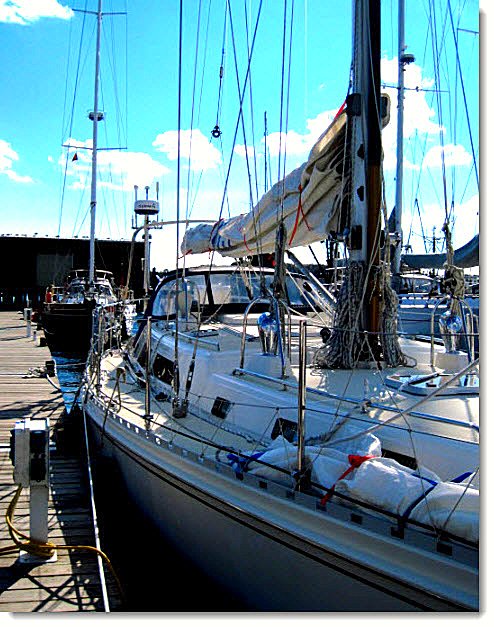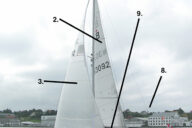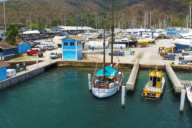Handle as much line-handling in or near the cockpit. That keeps you at the helm, where you have maximum control. Rig lines on both sides of the boat (as described below). If you need to shift tying up from port to starboard (or vice versa), you’re ready to go:
1. Make up Dual Bow Spring Lines.
Cleat off an after bow spring from a bow cleat on each side. Lead both bitter ends back to the cockpit. Tie large eyes in each end. Now you can just drape the eye over a cleat or piling without leaving the helm.
Make each spring line at least as long as your boat; better yet make each spring 1.5 to 2X your boat length. That way, you will have plenty of bitter end to work your boat into the pier smooth and easy.
2. Coil Down a Second Stern Line.
Set up a stern line on each side of the boat. Coil them onto the top of cockpit lockers so that they’re ready to use in an instant. Like the spring lines described earlier, make each stern line as long as practical so that you have enough left over to wrap the stern line onto a winch or make it up to a cleat.
3. Set Up Bow and Stern Anchors.
Make an anchor ready to deploy in less than 10 seconds from both bow and stern. Use a small grapnel or light claw from the stern. You need something you can toss over the side to slow the boat down in an emergency. Practice with your stern anchor in an open area clear of boats before you need to use it in an actual situation.
Your boat might require a different attachment point; this might be a quarter (corner) cleat or a stern cleat. Or, you may need to lead the line to clear installed gear like wind vanes, dinghy davits or swim ladders. Choose an anchor that’s easy to handle and sets fast. This will give you peace-of-mind in the event you need this vital “stern hook” in a jiffy.
4. Use horizontal fender clusters.
Hang fenders along each side. Cluster a group of two or three fenders at the point where you estimate you will first contact the pier. Hang horizontal fenders to give more surface area protection.
5. Take Advantage of Slack Intervals.
I believe not many things can make docking as difficult as a combination of wind and current. Or a cross setting current. And if you need to back into a slip, a cross current can play havoc with any approach. If at all possible, time your approach to the time of slack water or favorable docking current.
Check the current or tidal current tables and plan your arrival to coincide with the slack interval period–or that small space of time when the current speed drops to between 0 and 0.5 knots. This interval occurs at the end of a current cycle (flood or ebb) just before the current changes direction. Use this secret for more controlled, less stressful docking maneuvers.
6. Make Approaches Into the Elements.
If your docking approach involves wind and/or current, stop all forward momentum in a clear area near your final objective. Allow your boat to drift for a few seconds to determine element strength and direction. Gain the greatest control when you turn the bow or stern into the stronger of the two elements for your final approach.
7. Keep a Heaving Line Coiled and Ready.
Have you ever watched how a ship docks at a wharf? The ship’s deck crew heaves over a light “messenger” line (also called a “heaving line”) first so that the shoreside line handlers can pull the heavy docking lines over.
There may come a time when you need to get a small, light line over a lot of distance fast. You can heave a light line 30 feet or more with practice. Keep a “heaving line” ready on deck at all times to serve as a backup for your docking lines.
Make up a small diameter line 75-90 feet long with a “monkey’s fist” or similar weight tied to one end. Tie off the other end to secure it to your boat. Coil the line and break the coil in half. Heave the line a bit upwind of the target so that it sets down onto your aim point.
~~~~~~~~~~~~~~~~~~~~
Complete up to 90% of your docking preps before you enter any marina–including your own! This will allow you to concentrate on the approach and maneuvers for smoother, easier docking and maneuvering–wherever in the world you choose to sail or cruise!












